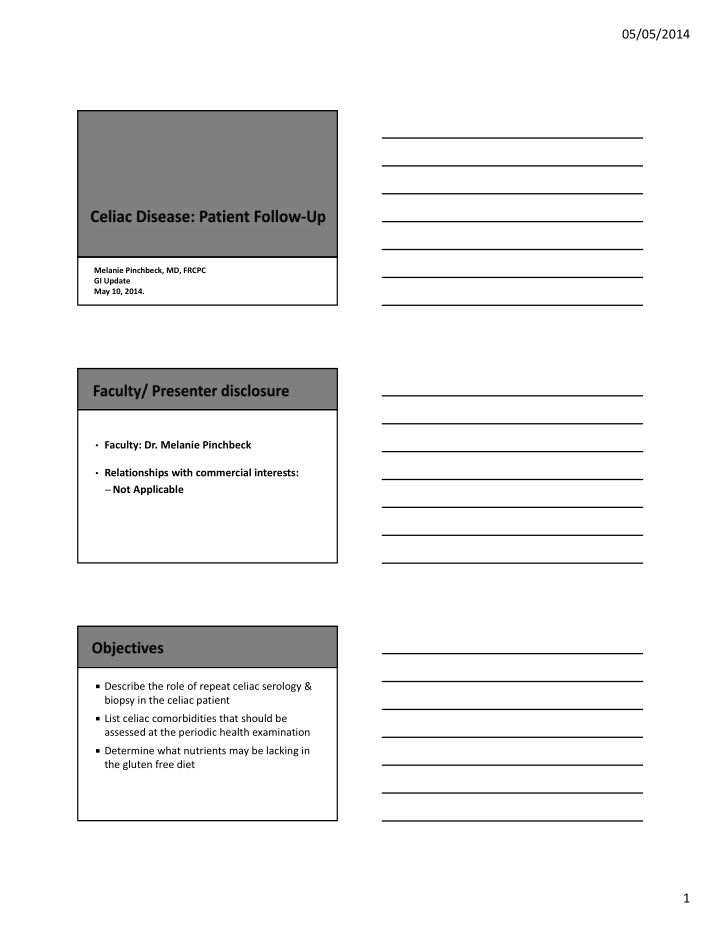



05/05/2014 Melanie Pinchbeck, MD, FRCPC GI Update May 10, 2014. • Faculty: Dr. Melanie Pinchbeck • Relationships with commercial interests: – Not Applicable Describe the role of repeat celiac serology & biopsy in the celiac patient List celiac comorbidities that should be assessed at the periodic health examination Determine what nutrients may be lacking in the gluten free diet 1
05/05/2014 “ Celiac disease is an immune ‐ based reaction to dietary gluten (storage protein for wheat, barley, and rye) that primarily affects the small intestine in those with a genetic predisposition and resolves with exclusion of gluten from the diet .” Rubio, et. al. 2013. Am J Gastroenterol . 108 : 656–676. PREVALENCE > 2X GENERAL LESS COMMON POPULATION Irritable bowel syndrome Dyspepsia Diarrhea with weight loss Amenorrhea Iron deficiency anemia Chronic fatigue Premature osteoporosis Constipation Abnormal liver enzymes Recurrent abdominal pain Dermatitis herpetiformis Epilepsy Peripheral neuropathy Ataxia Oral aphthous ulcers Unexplained infertility Growth failure Down’s syndrome Thyroid disease Rubio, et. al. 2013. Am J Gastroenterol . 108 : 656–676. Referral to a registered dietician Strict gluten free diet for life No products containing proteins from wheat, barley & rye Pure oats can be introduced slowly/carefully Baseline bone mineral density test Test for vitamin and mineral deficiencies Direct to the Canadian Celiac Association www.celiac.ca 2
05/05/2014 Rubio, et. al. 2013. Am J Gastroenterol . 108 : 656–676. Gluten free diet • Diagnosis of Referral to registered dietitian • celiac disease Canadian Celiac Association • confirmed Baseline DEXA • Baseline blood tests (e.g. CBC, • iron indices, liver enzymes, vitamin levels) Adapted from: Rubio, et. al. 2013. Am J Gastroenterol . 108 : 656–676. vitamins A, D, E, B12 zinc copper carotene folic acid ferritin, iron thiamine, vitamin B6, magnesium, selenium 3
05/05/2014 Diagnosis of celiac disease confirmed Assess symptom response • 3 ‐ 6 month Repeat serology • follow ‐ up Recheck abnormal labs • Adequate response? YES NO Symptoms improving Refer to dietician re: • • Decreasing anti ‐ tTG adherence to gluten • Nutritional deficiencies free diet • correcting Adapted from: Rubio, et. al. 2013. Am J Gastroenterol . 108 : 656–676. Anti ‐ tissue transglutaminase IgA Half ‐ life = 6 ‐ 8 weeks Levels should gradually decline on gluten free diet Normalization in 3 ‐ 12 months Check at baseline, after 3 ‐ 6 months and 12 months on a gluten free diet, then annually Diagnosis of celiac disease confirmed 3 ‐ 6 month follow ‐ up Assess symptom response • Repeat serology 1 year follow ‐ up • Recheck vitamins/ minerals • Repeat DEXA if indicated • Adequate response? YES NO Sx resolved Refer to dietician re: • • Normal anti ‐ tTG adherence to GFD • Nutritional deficiencies Consider referral to • • corrected GI 4
05/05/2014 Routine biopsy not routinely performed Indications: Failure to respond to a gluten free diet Recurrence of symptoms Non ‐ responsive celiac disease “persistent symptoms, signs or laboratory abnormalities typical of CD despite 6 – 12 months of dietary gluten avoidance” Rubio, et. al. 2013. Am J Gastroenterol . 108 : 656–676. Diagnosis of celiac disease confirmed 3 ‐ 6 month follow ‐ up 1 year follow ‐ up Assess for symptom recurrence • Repeat serology • Annual Check for nutritional deficiencies • associated with GFD examination Repeat DEXA if indicated • Adapted from: Rubio, et. al. 2013. Am J Gastroenterol . 108 : 656–676. Processed GFD foods have high levels of lipids, sugars, salt Patients on GFD ten to eat a diet high in fat, sugars, & calories High intake of total and saturated fats Increased trans fats Saturni, L., et al. 2010. Nutrients 2 :16 ‐ 34. 5
05/05/2014 Vitamin A Thiamine Fibre Folate Magnesium Calcium Iron Zinc Shepherd, S.J. & Gibson, P.R. J Hum Nutr Diet . 26 , 349–358 Increase dietary fruits/ vegetables to avoid micronutrient deficiencies (5+ servings/day) Choose gluten free products which are fortified with vitamin and minerals Alternative cereals (e.g. oats, quinoa, buckwheat) are a good source of vitamins, folic acid & fiber Saturni, L., et al. 2010. Nutrients 2 :16 ‐ 34. Nutritional Counselling deficiency Iron deficiency • Adherence to strict gluten free diet • Ingest sources of both heme (e.g. meat, fish, poultry) & non ‐ heme containing iron sources (e.g. nuts, seeds, legumes, dark green vegetables, dried fruits, eggs, quinoa, rice bran, soy flour • Foods high in Vitamin C aid non ‐ heme iron absorption Lactose • Can occur in untreated patients secondary to villous intolerance atrophy and decreased production of lactase • Temporary lactose free diet or use of lactase enzyme supplement Adapted from Case S, & Kaplan CR. 2003. Today’s Dietitian : 44 ‐ 49 6
05/05/2014 Nutritional Counselling deficiency Folate • Folate rich sources: legumes, green leafy vegetables, broccoli, asparagus, orange juice, liver, peanuts, walnuts, sesame seeds, sunflower seeds, bean flour, amaranth, flax Vitamin B12 • B12 rich sources: liver, eggs, milk, meat, poultry, fish, seafood Osteopenia/ • Choose foods rich in calcium and vitamin D osteoporosis • Calcium and Vitamin D supplements • Weight bearing exercise Adapted from Case S, & Kaplan CR. 2003. Today’s Dietitian : 44 ‐ 49 Symptoms, serology & other lab tests must be considered in evaluating response to a GFD Anti ‐ tTG should normalize within 12 months of initiating a gluten free diet, but mucosal healing may take 2 ‐ 3 years Indications for repeat mucosal biopsy include: failure to seroconvert, persistent symptoms or abnormal labs despite no evidence of inadvertent gluten exposure The restrictive gluten free diet is low in fiber & several vitamins/ minerals Patients on a GFD tend to ingest a high fat, high calorie diet Consultation with a dietician experienced in celiac disease/ gluten free diet counselling is instrumental in achieving patient adherence & good outcomes 7
05/05/2014 8
Recommend
More recommend